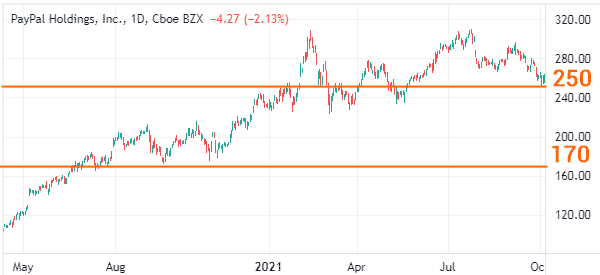There are two broad types of orders in the financial market. First, there is a market order, in which you ask the broker to initiate the trade at the exact moment. This is the most common type of order among most new traders.
Second, there is a limit order, which directs the broker to initiate a trade at a specific price, above or below the current price.
Limit orders can be in form of:
- buy limit
- sell limit
- buy stop
- sell stop
- trailing stop orders.
In this report, we will look at what a trailing stop order is and how you can use it in the market.
Table of Contents
What is a trailing stop order? Differences with the Standard one
The limit orders mentioned above are also known as conditional orders. This means that the order will only be placed if the price of an asset reaches a certain level.
A trailing stop order is a type of stop order that uses a trailing amount or percentage of the price.
A standard stop order is an order where you direct the broker to sell or buy an asset once the price is triggered. Once initiated, this type of order becomes a market order.
A trailing stop order, on the other hand, is mostly held in the cloud and implemented once the conditions are met.
For a buy order, it will be triggered by changes inside the bid price while for a sell order, it is triggered when there are changes in the inside ask price.
How a trailing stop order works
As mentioned above, a trailing stop order is relatively different from a standard stop loss. A standard stop-loss is fixed and will be implemented when a stock drops or rises to where the order has been placed.
A trailing stop works like this. It directs the broker to move the stop-loss depending on the overall price action of the stock. It is based on the distance of an asset from the current market price. You can set it based on a fixed amount of money or a percentage.
For example, you can place the trailing stop about 3% of the market price. In this case, the stop will be implemented when the price moves below the current price by about 3%.
Most traders using trailing stops fail by placing the orders very tight or very wide. For example, when you place the stop at about 3%, it can be triggered easily since assets tend to make these fluctuations. On the other hand, if you place it at 20%, it means that it will be too wide.
Therefore, you should try to find a balance. In most cases, a trailing stop of about 10% is usually adequate. For example, if you have a $10,000 account, having 10% trailing stop means that the order will be stopped when it falls by $1,000.
How to place a trailing stop order
You can set the trailing stop order either as an amount or a percentage. When using a percentage trailing amount for sell orders, the distance between the target price will become bigger as the price rises.
Similarly, for buy trailing stop orders, the point distance between the target price will widen as the price falls.
Example of a trailing stop order
Here is an example of a trailing stop order. The stock of a company is trading at $30 and you place a buy trade. As time goes on, the shares jump to $33.
To protect your profits, you initiate a sell trailing stop order with a stop price of $2 below the current price. Within a while, the stock reaches $35 and then starts to drop, which is not in your favour.
In this case, you will benefit with the initial buy order and the trailing stop order.
Let us look at another example. In the chart below, we see that the PayPal stock price made a down gap and is trading at $204. If we think that the stock will rise to $250, you can have your stop at $170. In this case, it means that the stock can move lower by about 30 points before being stopped.

Since you are entering a trailing stop, you need to enter what is known as a trailing step amount. This step is an important figure that dictates how much the stock needs to move before your stop is triggered.
In this case, if you set your next stop to move every time the PayPal stoc moves by 10 points, it means that the stop will move to $180 when the stock rises to $260.
Why use trailing stop orders?
There are several benefits for using trailing stop orders. First, the orders provide an excellent way to manage risks in the market as explained in the example above.
Second, they offer a good way to trade for people doing other things. For example, if you trade part time, the orders can help you make money while managing risk.
Risks of trailing stop orders
While these orders are good, they also come with several risks. Some of the common risks are stock splits, gaps, liquidity and no market for the asset.
Stock Split
A stock split happens when a company whose share price is very high decides to split it.
For example, a company trading at $100 can decide to split it to $50. When this happens, your trailing stop order may be initiated prematurely because most brokers use data from third party providers.
Gap
A gap is a common thing in the market. For example, if the share price of a company is at $50, it can jump to $60 in a single session if there is a major news.
If it happens, it may affect your order.
Execution
There is also a risk of execution, especially in a time of high volatility. If this happens, the order may be initiated at a different price than what you initiated.
No Market
Another risk is when there is no market order for the asset. When this happens, it means that your trailing stop order may not trade. However, this is a problem that is not very popular.
Final thoughts
Trailing stop orders are an excellent way to manage your risks in the financial market. However, as you can see above, the orders come with their own risks.
Therefore, we recommend that you first experiment them in your paper trading accounts. This will help you to know how to execute them well.
External Useful Resources
- How the Trailing Stop/Stop-Loss Combo Can Lead to Winning Trades – Investopedia
- Trailing Stop Loss vs. Trailing Stop Limit: Which Should You Use? – The Robust Trader





